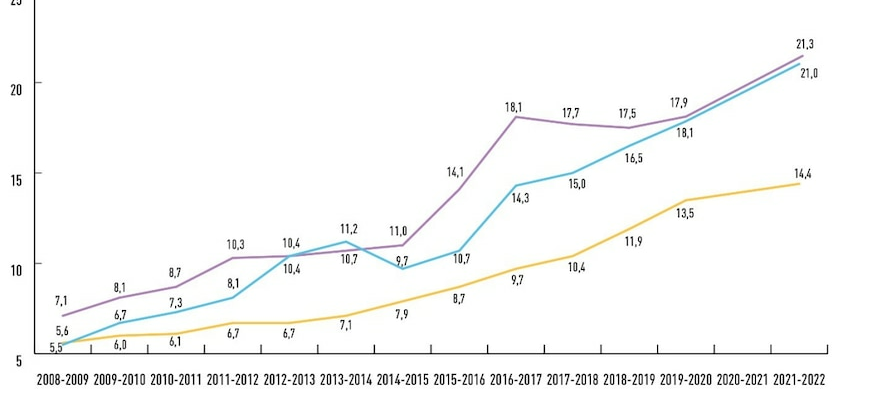Regulation of a market controlled by mafia networks, job creation, new tax revenue to finance information and prevention campaigns, and even the health system. The legalization of cannabis is always accompanied by its share of promises, which come up against very real fears of potential damage to public health.
In France, the issue of legalizing cannabis is at a standstill. The idea is not a major issue for the country’s major political parties. In the rest of Europe, positions are slowly evolving. Last April, Germany became the third European country to partially legalize recreational cannabis, after Malta and Luxembourg. But these decisions, which are still recent, have not yet revealed all their lessons.
In the United States, the legalization of marijuana dates back more than ten years in some states. The French Observatory of Drugs and Addictive Tendencies (OFDT) therefore looked at the impacts of these policies in three states (California, Washington, Oregon). This analysis, proposed in the Astracan survey (Strategic analysis of cannabis regulation policies) published this Monday, September 30, is rich in lessons. “We have carried out work for several years, in the field, in order to obtain a transversal view of what the regulation of the cannabis market covers in these three States, as well as its economic and public health impacts,” explains Ivana Obradovic, deputy director of the OFDT and author of the report.
The black market in decline, persistence of the “gray market”
In the United States, the plant is legalized in certain states, but remains classified as an illegal drug at the federal level, which creates an astonishing patchwork of rules. Nevertheless, these legalization projects all display a common objective: “to reinforce the ban on minors’ access to cannabis, to regain control of the (illegal) market and to better protect adult consumers through better control of the substance, of its uses and its consequences”, recalls the OFDT report. Some states also wanted to develop a profitable economic sector (California, Oregon), while promoting access for “small operators” to the legal market (California) and avoiding the creation of monopolies (Washington).
“Everywhere, cannabis has been a very flourishing market which has professionalized and developed. This sector has industrialized, a major change which has gone hand in hand with the development of a direct economy (the production and creation of new product ranges) and indirect: creation of biotechnology companies, development of research but also of specific marketing”, summarizes Ivana Obradovic. The legalization of cannabis has therefore gone hand in hand with an increase in the supply of derivative products, which has generated significant economic profits.
Several difficulties nevertheless appear, including those linked to the transition from the illicit market to the legal market. “In the three states studied, the black market is gradually declining,” the report states. But legalization still seems to have helped to juxtapose legal, illicit and “gray” markets. Thus, the legal market is sometimes supplied by cannabis produced illegally, but sold in uncontrolled dispensaries offering cannabis for medical use. The illegal market, for its part, sometimes supplies itself with legally produced cannabis, but cannot find an outlet on the legal market due to a lack of sufficient physical points of sale and because of the federal ban which prevents the export of legal cannabis. , including from one state to another.
Increase in consumption among adults
The survey also shows that, contrary to the promises of legalization policies, the development of the legal cannabis market has only very marginally revolved around public health. Thus, constraints on the packaging and labeling rules for cannabis products remain weak, as do attempts to limit advertising and promotion of cannabis-derived products. Above all, the authorization of commercial innovation has opened the way to a rapid diversification of the offer and an expansion of clienteles.
Fortunately, cannabis use among minors – which remains prohibited despite legalization – has decreased. “This decrease was already visible before legalization,” recalls Ivana Obradovic. “In any case, legalization has not reversed this decrease.” On the other hand, consumption among adults over 25 increased very quickly in the three states studied. This increase is explained, according to the specialist, by the increase in the offer of derived products, including new synthetic products, but also niche products, such as “gourmet cannabis”, which is booming in California, which imitate the promotional codes and know-how of oenology and the luxury industry.
The upward trend is uniform beyond 25 years. And cannabis use also increased among young adults (18-25 years old) in the first years following legalization, sometimes in significant proportions.
© / OFDT/NSDUH
“There is also a whole marketing game around the different cannabinoids – there are around a hundred in the cannabis plant, in addition to THC and CBD – but also terpenes, that is to say the aromas, which which has resulted in the almost infinite creation of new products,” explains Ivana Obradovic. New ways of consuming have also appeared, including dabbing, which consists of smoking cannabis like opium, and especially regular vaping.
The “concentrates” are worrying
More worrying, the OFDT notes a lack of restriction on the composition of authorized products. The level of THC, the main psychoactive component of the plant, has not been capped. “This gave rise to the creation of ‘concentrates’, products in yellow or beige tones, liquid or solid, sometimes smoked but mainly used in more or less designer, more or less trendy vaporizers,” continues the specialist. Some concentrates display THC levels of up to 80%, sometimes even 90%, compared to generally 15 to 25% for weed or “classic” resins. On the Internet, many videos show users collapsing after a single puff of this type of product.
Economic success is there. In the states of Washington and Oregon, “concentrates” represent a third of cannabis sales over the past two years. But, beyond the risk of acute poisoning, the long-term health effects are not known, which opens up large areas of uncertainty, especially in such an unbridled market.

Cosmetic product, to smoke, vape, dab or even ingest. Marketing creativity seems endless.
© / OFDT
“It has been 10 years since cannabis was legalized in certain states, but it is still too early to assess the impacts on health, particularly mental health, in the medium and long term,” warns the deputy director of the OFDT, who nevertheless adds that legalization has allowed a new surge in the development of research on the impact of cannabinoids on health. One thing seems clear: the more physical points of sale there are, the greater the public health problems.
The report finally points to another promise kept. Legalization was supposed to make it possible to generate new tax revenues which would finance prevention campaigns. “But when we look at the allocation of resources, we realize that there is little money dedicated to this objective,” says Ivana Obradovic. Thus, one of the key elements of legalization aimed at greater public health safety is, once again, put aside.
.
